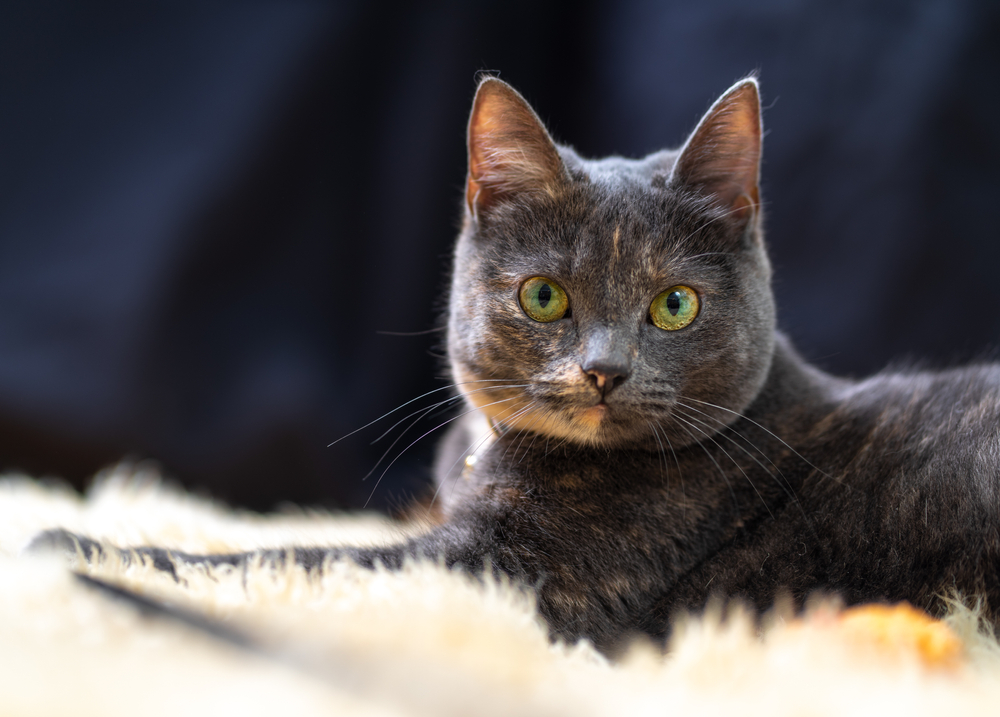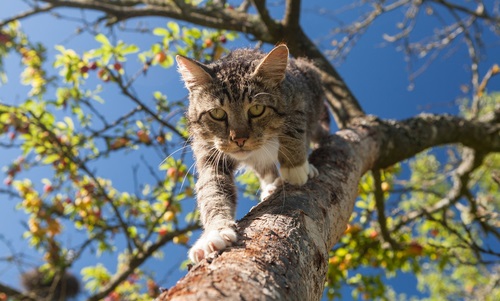Outside of their inquisitive meows, there’s no more iconic feline sound than the hair-raising, undulating yowl. Easy to hear – and admittedly, even easier to become tired of – it’s a sound that has a great deal of meaning for cats, as well as some very different nuances, depending on when and where they take up the call. To answer “Why do cats yowl?” accurately, it’s important to explore the basics of cat vocalizations, as well as what they mean to the average pet parent.
Why Do Cats Meow?
Ask most people – cat-owners or otherwise – what sound a cat makes, and the answer is generally always “meow.” This simple feline communication is so familiar, it makes an appearance on children’s talking toys and kindergarten lessons – but there are a few surprising facts behind it, too:
- Most adult cats wouldn’t meow on their own in the wild: What owners of adult cats recognize as the “meow” of greeting is actually a holdover from kittenhood, and a response learned as a part of domestication. The high-pitched meows and squeaks issued by young kittens are meant to solicit help or attention from the mother cat. As a cat grows older, he obviously doesn’t need his mother’s assistance any longer, but cats have learned that a well-timed “meow” has the same attention-getting effect on their human companions.
- Cats left to their own devices are more likely to meow: If a pet parent has a demanding job that requires long hours at the office or frequent travel, their cat is likely to be a little more vocal. Cats are intelligent and likely have connected the idea of “trading sounds” as part of the human pack-bonding experience. When a cat frequently observes his human talking to other humans, watching television, or chatting on the phone, it’s only natural he’d begin to learn that sounds equate to connection and attention.
- They’re not shy about faking enthusiasm for food: As most pet parents in a multi-person household can attest, a sly cat won’t think twice about pulling a rather convincing “I’m sooo hungry please feed me!” meow routine for anyone that will listen. Whether they’re actively attempting to “trick” the next human that stops by or they’ve simply learned that meowing plaintively equals food, no one can say for sure.
These sounds may be soft or demanding, but they usually don’t indicate any health or behavioral problems, with the exception of “calling” meows triggered by separation anxiety or confusion.
Meowing Versus Yowling
There’s a distinct difference between the neutral and pleased vocal expressions of a cat – purrs, “chirps,” and meows – and yowling. Consider for a moment the word hey in English language and American culture.
It can be used softly as a way to get someone’s attention or an intimate greeting – hey, can I maybe talk to you for a minute?
It can be used at normal speaking volume to get someone’s attention – Hey, hand me that wrench, will you?
And finally, it can be used as a warning or an exclamation of anger – HEY! What do you think you’re doing in my house?
Cat vocalizations follow a similar route as this word, in terms of volume and tone. Meows, purrs, and chirps fall under the first two examples, cats use them to communicate and inquire about their surroundings when spending time with their pet parents. Yowls, on the other hand, are decidedly in the last category. Yowls will typically undulate – move up and down in tonal quality – and will be accompanied by low growls or even sub-vocalizations meant for another cat to hear. They are usually triggered and repeated until the source of a cat’s agitation (e.g., unwanted confinement, an intruder, or pain) is removed.
The Reasons Behind Cat Yowling
A yowl from a cat almost always accompanies distress of some type – if he is yowling, he is typically upset about an injury or a situation he finds himself in. A yowl can mean several things:
- I want my freedom right now! A familiar sound from an angry stray caught in a humane trap or a cat unwillingly on the vet’s examination table; a yowl is his way of letting everyone know that his teeth and claws are about to start clearing a path. Pet care professionals and trap-neuter-release volunteers know that yowls signal something important: protective barriers like thick gloves or a wrapping towel are probably a smart precaution. A cat may continue to yowl and thrash once they are contained in a cage, carrier, or humane trap – it’s an instinctual behavior deeply rooted in anger and displeasure.
- I want you to leave! Many cat owners wonder “why do cats yowl at each other?” The answer has to do with territory. A feline equivalent of a dog’s low growl, a yowl is fair warning that a human or another cat has been noticed and that they are decidedly unwelcome. Yowls are the soundtrack to feline territory fights, issued as the cat arches his back and attempts to intimidate a potential opponent. Yowls are usually interspersed with hisses and “screams” once combat/contact has begun between two cats (or an extremely unlucky human in the wrong place at the wrong time).
- I’m in pain or distress! If a yowl sounds closer to a moan of pain than a hiss of surprise, it may mean that a cat is suffering from an injury or ailment. This may be physical – a hurt leg from a fall – or cognitive, such as an older cat with dementia and confusion. If a cat starts uncharacteristically yowling without a cause (e.g., there are no unfamiliar or “enemy” cats in the vicinity, and a female cat isn’t in heat), their pet parent should take them immediately to an emergency vet for a checkup. Remember: cats are predators, which means they are genetically inclined to keep pain and discomfort hidden – if they’re expressing it, something is probably wrong.
- I’m looking for a boyfriend! In female cats, yowling indicates a different sort of distress – a loneliness of the primal variety. When a female cat’s body is in peak fertility, she is considered to be “in heat,” and actively and loudly searches for nearby male cats to mate with. Any pet parent with an unspayed female cat will agree that this behavioral cycle is unrelenting and extremely unpleasant, both to the ears and to a good night’s sleep.
The female may “mark” her territory with small bursts of urine to attract tom (male) cats, and yowl incessantly for several days so they can zero in on her location. While the term “caterwauling” refers to yowls in general, this style of yowl is what’s most commonly associated with this ear-splitting descriptor. Thankfully, once a female cat has been spayed, she no longer goes “into heat,” and will no longer periodically yowl for a mate.
How Can I Stop My Cat From Yowling?
While knowing the causes behind cat yowling are important, most pet parents are more invested in making it stop. Whether they’re losing sleep from frequent feline vocalizations or worried about their furry friend, stopping yowling behaviors quickly is ideal for humans and cats alike.
- If the yowling is occurring between cats within the same household: Calming supplements given regularly may help turn the dial down on inter-cat aggression. Additionally, hormonal diffusers can also help cats feel more secure and less prone to fight, yowl at one another, or mark around the house with urine.
- If the yowling is occurring because of a female in heat: unfortunately, spaying is the only lasting solution to mating-inspired yowls. Even if the males in her area or household are neutered and incapable of mating, she will still loudly exhibit mating behaviors until she’s spayed. A vet professional can offer guidance on the right age to make a spay appointment, but will typically not spay a cat while she is actively in heat.
- If the yowling is occurring because of an injury or ailment: a proper diagnosis, as soon as possible, is the next step. Again, if a cat is vocalizing pain or distress, it’s serious and should be seen to immediately or as soon as possible. The injury or pain a cat is feeling may be internal or cognitive, so don’t assume just because there are no visible wounds that everything is alright.
Just like whispers, murmurs, and shouts of “hey” in humans, yowls are an important part of a cat’s communication tools. That said, if they’re being heard too often, chances are he/ she is unhappy and needs a change of some sort or assistance from his pet parent. If this behavior is due to anxiety or stress, you may want to look into CBD for cats.
Sources Cited:
1) Duno, Steve. “12 Sound Cats Make and What They Mean.” Moderncat (moderncat.com), (no published date), https://moderncat.com/articles/12-sounds-cats-make-and-what-they-mean/#:~:text=The%20yowl%20is%20often%20a,isn’t%20to%20her%20liking. Accessed January 31, 2021.
2) “Meowing and Yowling.” ASPCA (aspca.org), (no published date), https://www.aspca.org/pet-care/cat-care/common-cat-behavior-issues/meowing-and-yowling. Accessed January 31, 2021.
3) “Cats and Excessive Meowing.” Fetch by WebMD (pets.webmd.com), (no published date), https://pets.webmd.com/cats/guide/cats-excessive-meowing#1. Accessed January 31, 2021.
4) Buzhardt, Lynn, DVM. “The Cat’s Meow! Caterwauling in Cats.” VCA (vcahospitals.com), (no published date), https://vcahospitals.com/know-your-pet/the-cats-meow-caterwauling-in-cats. Accessed January 31, 2021.







